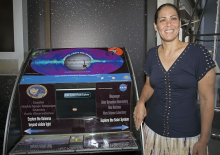Ciencia Boricua Profiles
Every month we profile the work of an outstanding CienciaPR member or discuss a topic of relevance to our community
Gilberto Cintrón Morelo: A passion for science born from the sea
Submitted by Wilson Gonzalez-Espada and Reyna I. Martínez De Luna on 16 February 2014 - 6:46pm
Listening to the whispers from the stars
Submitted by Wilson Gonzalez-Espada on

















